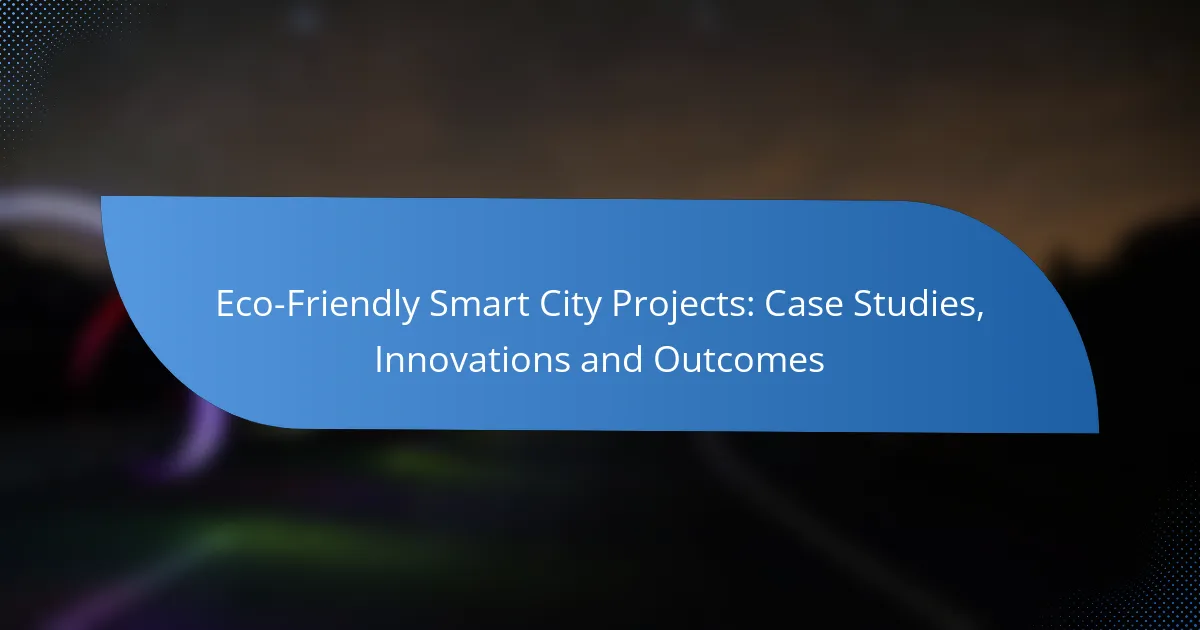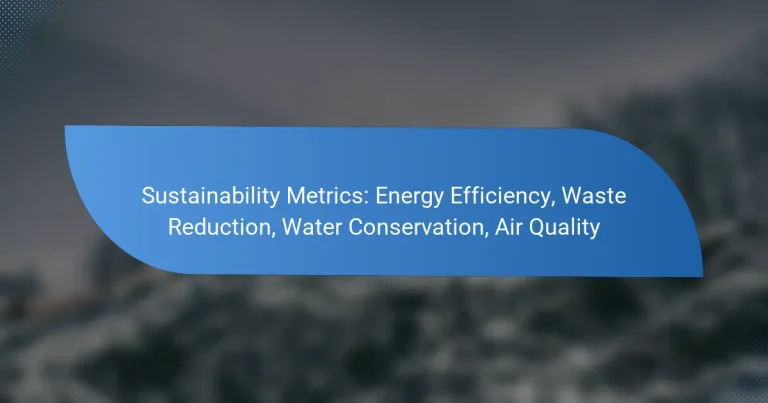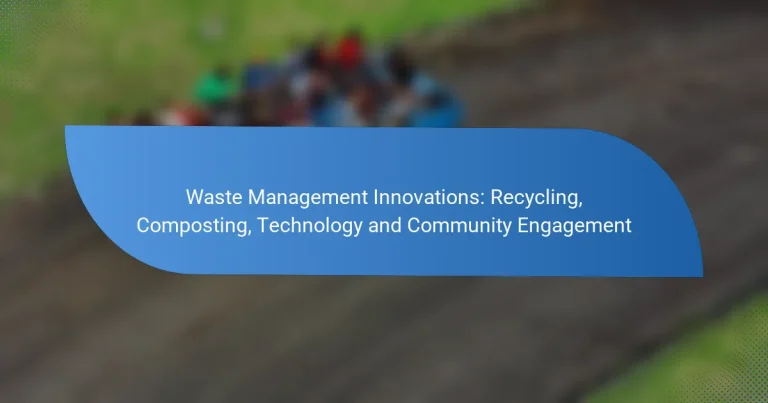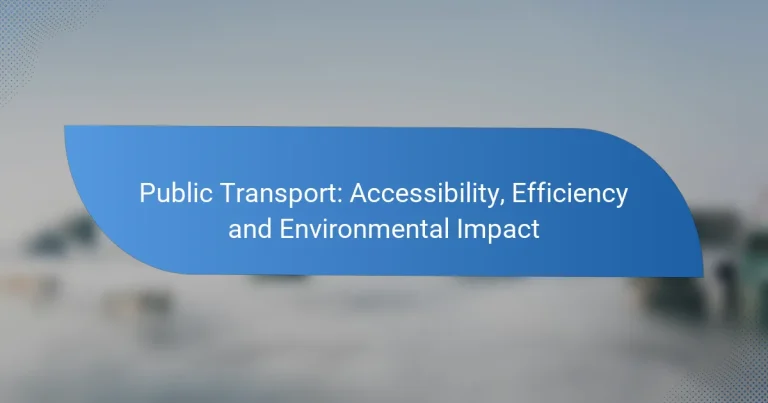Eco-Friendly Smart City Projects: Case Studies, Innovations and Outcomes
Eco-friendly smart city projects are revolutionizing urban living by merging technology with sustainability to create efficient, livable environments. These initiatives focus on reducing environmental impact and enhancing resource efficiency through innovations in energy, waste management, and transportation. By leveraging advanced technologies such as the Internet of Things (IoT) and renewable energy, these cities strive to foster a healthier and more sustainable future for their residents.
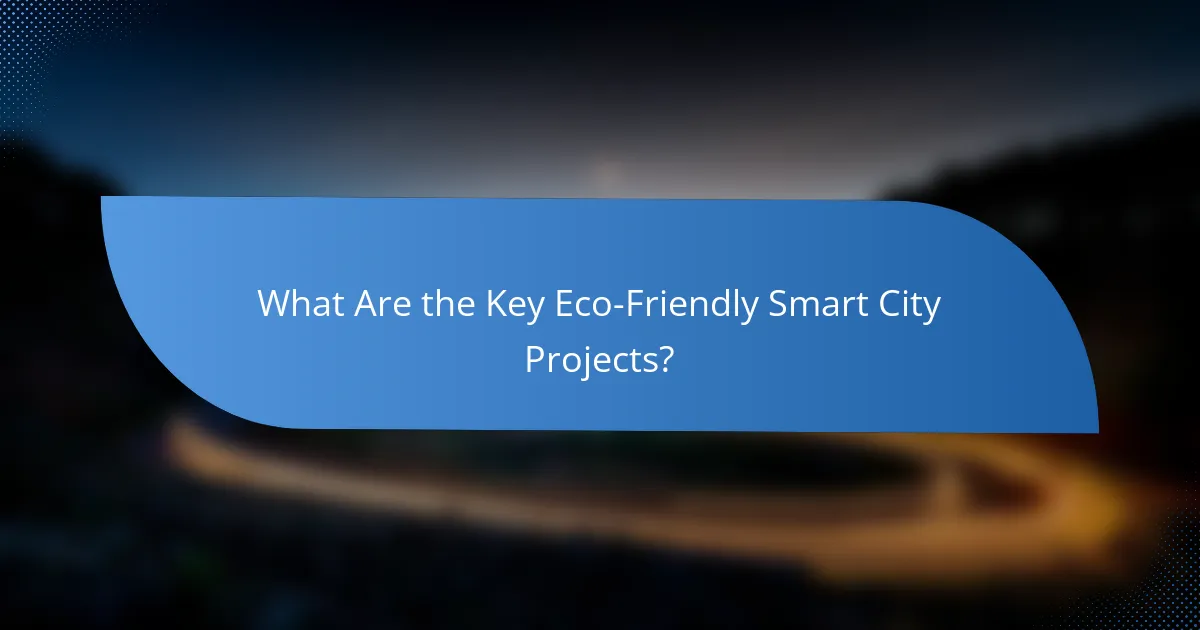
What Are the Key Eco-Friendly Smart City Projects?
Key eco-friendly smart city projects focus on integrating technology and sustainability to enhance urban living. These initiatives aim to reduce environmental impact, improve resource efficiency, and promote a higher quality of life for residents.
Barcelona Smart City Initiative
The Barcelona Smart City Initiative leverages technology to improve urban services and promote sustainability. It includes smart lighting, waste management systems, and energy-efficient buildings, all aimed at reducing the city’s carbon footprint.
Key features include the use of sensors to monitor air quality and traffic, allowing for real-time data analysis and decision-making. This initiative has led to a significant reduction in energy consumption and improved public transport efficiency.
Singapore Green Plan 2030
The Singapore Green Plan 2030 is a comprehensive roadmap aimed at promoting sustainability and enhancing the quality of life in the city-state. It focuses on areas such as green urban spaces, sustainable transport, and energy efficiency.
One of the plan’s key components is the goal to increase the city’s green cover to 50% by 2030. This includes initiatives like vertical gardens and rooftop greenery, which help mitigate urban heat and improve biodiversity.
Amsterdam Circular Economy
Amsterdam’s Circular Economy initiative aims to minimize waste and promote the reuse of materials in urban development. The city encourages businesses and residents to adopt sustainable practices, reducing reliance on finite resources.
Key strategies include creating a network for sharing resources and implementing policies that incentivize recycling and upcycling. This approach has led to a significant decrease in waste sent to landfills and increased local job opportunities in green sectors.
Los Angeles Smart Lighting Program
The Los Angeles Smart Lighting Program focuses on upgrading streetlights to energy-efficient LED systems equipped with smart technology. This initiative aims to reduce energy consumption and enhance public safety through improved visibility.
The program has replaced tens of thousands of traditional streetlights, resulting in substantial energy savings and lower maintenance costs. Additionally, the smart lighting can be integrated with sensors to monitor traffic and environmental conditions.
Copenhagen Climate Resilient City
Copenhagen’s Climate Resilient City initiative addresses the challenges posed by climate change through innovative urban planning and infrastructure. The city aims to become carbon neutral by 2025, implementing measures to manage stormwater and reduce heat islands.
Key projects include green roofs, permeable pavements, and extensive bike lanes that promote sustainable transport. These efforts not only enhance the city’s resilience to climate impacts but also improve the overall quality of urban life.

How Do Smart Cities Promote Sustainability?
Smart cities enhance sustainability by integrating technology to optimize resource use, reduce waste, and improve urban living conditions. Through innovative solutions in energy, waste management, and transportation, these cities aim to create a more efficient and environmentally friendly urban environment.
Energy Efficiency Technologies
Energy efficiency technologies in smart cities focus on reducing energy consumption while maintaining comfort and functionality. Smart grids, for instance, allow for real-time monitoring and management of energy use, enabling cities to balance supply and demand more effectively.
Examples include smart meters that provide residents with detailed usage data, encouraging them to adjust their consumption habits. Additionally, LED street lighting and energy-efficient buildings contribute to significant reductions in overall energy use, often achieving savings of 30-50% compared to traditional systems.
Waste Management Innovations
Innovations in waste management are crucial for smart cities aiming to minimize landfill use and enhance recycling rates. Technologies such as smart bins equipped with sensors can monitor waste levels and optimize collection routes, reducing fuel consumption and operational costs.
Some cities have implemented waste-to-energy plants that convert organic waste into energy, further promoting sustainability. Public awareness campaigns and incentive programs can also encourage residents to participate in recycling and composting initiatives, leading to a more circular economy.
Green Transportation Solutions
Green transportation solutions in smart cities prioritize reducing carbon emissions and improving air quality. Electric vehicles (EVs) and public transportation systems are increasingly integrated with smart technology to enhance efficiency and accessibility.
For instance, cities may offer incentives for EV use, such as reduced parking fees or access to dedicated lanes. Additionally, bike-sharing programs and pedestrian-friendly infrastructure encourage sustainable commuting options, contributing to lower traffic congestion and pollution levels.
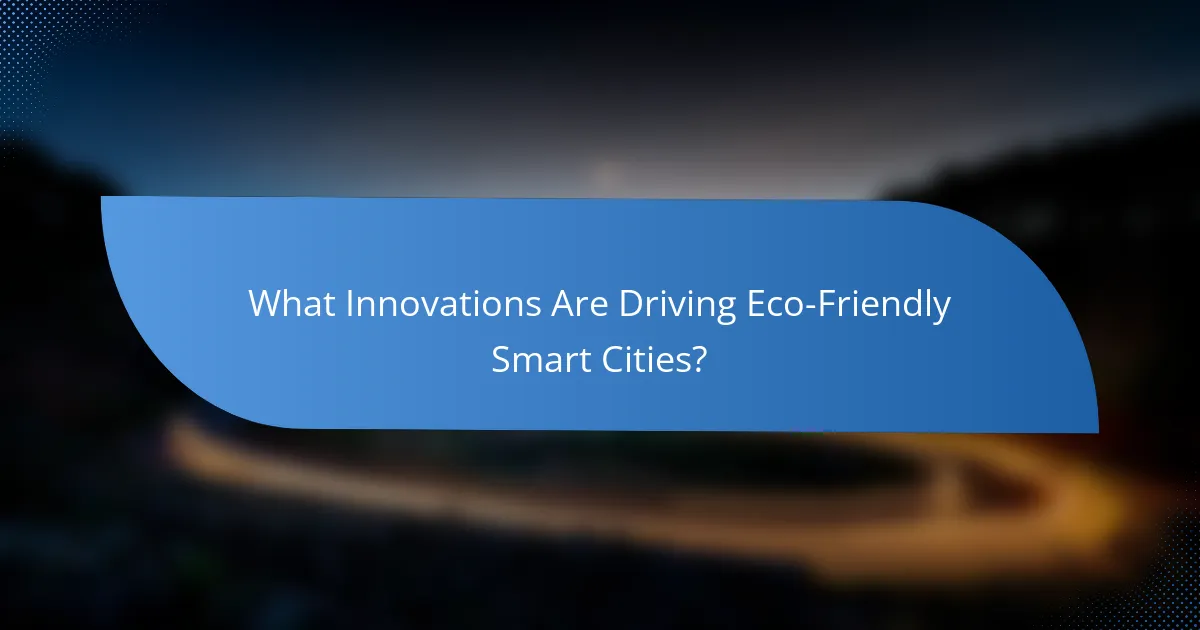
What Innovations Are Driving Eco-Friendly Smart Cities?
Innovations driving eco-friendly smart cities include advanced technologies that enhance urban living while minimizing environmental impact. Key areas of focus are the Internet of Things (IoT), renewable energy sources, and efficient water management systems.
IoT for Urban Management
The Internet of Things (IoT) plays a crucial role in urban management by connecting devices and systems to optimize city operations. Smart sensors can monitor traffic patterns, air quality, and energy usage in real-time, allowing for data-driven decision-making.
For example, cities like Barcelona have implemented smart streetlights that adjust brightness based on pedestrian activity, reducing energy consumption. When deploying IoT solutions, it’s essential to consider data privacy and security to protect citizens’ information.
Renewable Energy Integration
Integrating renewable energy sources, such as solar and wind, is vital for sustainable urban development. Smart cities are increasingly adopting microgrids that allow for localized energy production and consumption, enhancing resilience against outages.
For instance, San Diego has invested in solar energy projects that provide power to public facilities, significantly lowering operational costs. When planning renewable energy initiatives, cities should evaluate local resources and community needs to ensure effective implementation.
Smart Water Management Systems
Smart water management systems utilize technology to monitor and optimize water usage, reducing waste and improving efficiency. These systems can detect leaks, manage irrigation, and analyze consumption patterns to promote sustainable practices.
A notable example is the city of Amsterdam, which employs smart meters to track water usage and alert residents to unusual consumption patterns. Implementing these systems requires collaboration with local utilities and ongoing public education to encourage responsible water use.
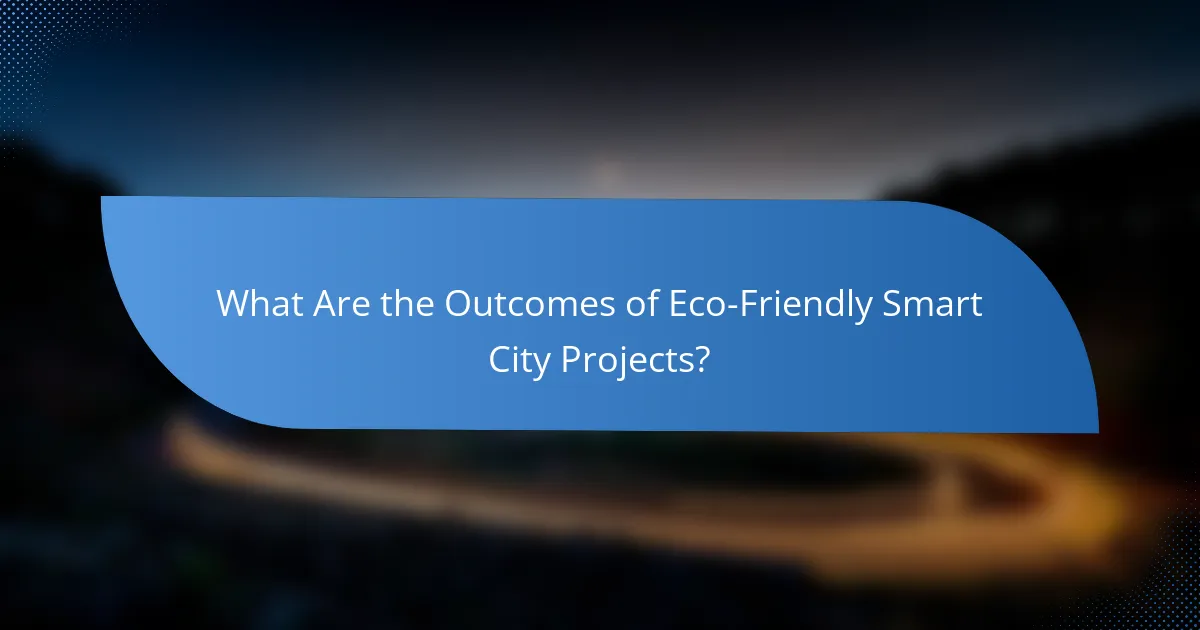
What Are the Outcomes of Eco-Friendly Smart City Projects?
Eco-friendly smart city projects lead to significant improvements in sustainability, urban living, and economic vitality. These initiatives often result in reduced carbon emissions, enhanced quality of life for residents, and increased economic opportunities.
Reduction in Carbon Emissions
One of the primary outcomes of eco-friendly smart city projects is a notable reduction in carbon emissions. By integrating renewable energy sources, such as solar and wind, cities can decrease their reliance on fossil fuels, leading to lower greenhouse gas outputs.
Additionally, smart transportation systems, including electric public transit and bike-sharing programs, encourage residents to opt for greener travel options. For instance, cities like Amsterdam have seen substantial drops in emissions due to their extensive cycling infrastructure.
Improved Quality of Life
Eco-friendly smart city initiatives significantly enhance the quality of life for urban residents. Improved air quality, thanks to reduced emissions, leads to better health outcomes and fewer respiratory issues among the population.
Moreover, the incorporation of green spaces and smart technologies, such as efficient waste management systems, contributes to a more pleasant living environment. Cities like Singapore exemplify this with their vertical gardens and smart parks that promote community engagement and well-being.
Economic Growth and Job Creation
Investing in eco-friendly smart city projects often stimulates economic growth and creates new job opportunities. The demand for green technologies and sustainable practices fosters innovation and attracts businesses focused on sustainability.
For example, cities that prioritize renewable energy projects can create jobs in installation, maintenance, and research. Furthermore, the development of smart infrastructure can lead to increased tourism and investment, boosting local economies.

What Criteria Should Be Considered for Smart City Projects?
Smart city projects should consider criteria such as community engagement, technological infrastructure, and regulatory compliance to ensure they meet the needs of residents while promoting sustainability. These factors help create a cohesive plan that aligns technological advancements with the social and legal frameworks of the city.
Community Engagement
Community engagement is crucial for the success of smart city projects. It involves actively involving residents in the planning and decision-making processes to ensure their needs and preferences are addressed. Effective strategies include public forums, surveys, and workshops that gather input and foster a sense of ownership among citizens.
Engaging the community can lead to higher acceptance of new technologies and initiatives. For instance, cities that have implemented participatory budgeting have seen increased public satisfaction and trust in local governance. Ensuring diverse representation in engagement efforts can enhance inclusivity and equity.
Technological Infrastructure
A robust technological infrastructure is essential for smart city projects to function effectively. This includes reliable internet connectivity, data management systems, and IoT devices that facilitate real-time monitoring and communication. Cities should assess their existing infrastructure and identify gaps that need to be filled to support smart solutions.
Investing in scalable and flexible technology is vital. For example, cities can adopt cloud-based platforms that allow for easy integration of new applications as needs evolve. Additionally, prioritizing cybersecurity measures will protect sensitive data and maintain public trust in smart city systems.
Regulatory Compliance
Regulatory compliance ensures that smart city projects adhere to local, national, and international laws and standards. This includes data protection regulations, environmental laws, and urban planning codes. Understanding these requirements at the outset can prevent costly delays and legal issues later on.
It is advisable for city planners to collaborate with legal experts and regulatory bodies during the project development phase. Regular audits and assessments can help ensure ongoing compliance as technologies and regulations change. Staying informed about emerging regulations, such as those related to data privacy, is also crucial for maintaining compliance and public confidence.
